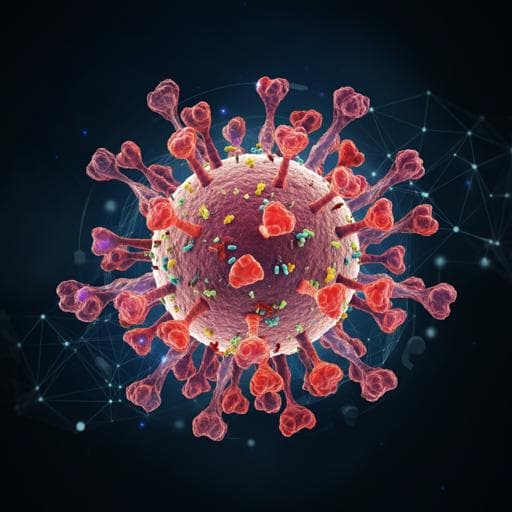
Political Science
The mass public's science literacy and co-production during the COVID-19 pandemic: empirical evidence from 140 cities in China
H. Qin, Z. Xie, et al.
This study reveals a compelling connection between public science literacy and co-production efforts during the COVID-19 pandemic, showcasing that a mere 1% increase in science literacy can result in a remarkable 14.2% uplift in collaborative initiatives. Conducted by Haibo Qin, Zhongxuan Xie, Huping Shang, Yong Sun, Xiaohui Yang, and Mengming Li across 140 Chinese cities, the findings underscore the crucial role education and local government play in enhancing public health responses.
~3 min • Beginner • English
Introduction
The COVID-19 pandemic represents a major global health and economic crisis, underscoring the importance of public participation in measures such as lockdowns, social distancing, mask wearing, and vaccination. Co-production is defined as the combined effort of service agents and citizens in delivering public services; in this context, the collective efforts of the public and government against COVID-19 constitute co-production. While prior work examines individual factors like individualism, anti-intellectualism, and scientific skepticism, the role of science literacy has received limited empirical attention. Science literacy, as defined by OECD and the National Academies, encompasses the ability to engage with science-related issues and apply knowledge to practical problems, such as health and survival. The study posits that higher public science literacy—through knowledge, trust in science, and scientific spirit—facilitates voluntary adherence to preventive behaviors and policy compliance, making the public an active co-producer in pandemic governance. Despite global emphasis on science literacy during COVID-19, empirical verification of its relationship with co-production is lacking. China provides a suitable context due to extensive public–government collaboration during the outbreak and limited ideological polarization regarding science. This study uses 2020 city-level data on civic science literacy (China Association for Science and Technology) and Baidu Index search volumes for co-production-related keywords (Dec 27, 2019–Apr 28, 2020) across 140 cities. It tests whether science literacy promotes co-production and whether regional education level and local government capacity moderate this relationship.
Literature Review
The literature indicates that trust in science, scientific spirit, and scientific knowledge help address complex societal challenges requiring expertise (e.g., climate change, technology, biomedicine). For COVID-19, higher science literacy and trust in science correlate with adherence to measures like distancing, mask wearing, and vaccination. However, prior studies often used narrow indicators of science literacy and subjective measures of co-production, limiting generalizability. With widespread internet penetration, online behavioral indicators (e.g., search data) offer objective measures of voluntary engagement. The study develops three hypotheses: H1: Public science literacy significantly promotes co-production against the pandemic. H2: Regional educational levels positively moderate the effect of science literacy on co-production. H3: Local government capacity positively moderates the effect of science literacy on co-production. Theoretical arguments suggest education enhances civic engagement and comprehension of evolving policies, while stronger government capacity improves crisis response, communication, and public trust, thereby facilitating co-production.
Methodology
Design and estimation: The study employs city-level cross-sectional analysis across 140 Chinese cities. Ordinary least squares (OLS) regression estimates the relationship between public science literacy and public co-production (measured via search behavior), controlling for environmental- and individual-level factors. The baseline model: Co-production_i = β0 + β1 ScienceLiteracy_i + Controls + ε_i. Endogeneity concern: Science literacy may correlate with search behavior. To address this, two-stage least squares (2SLS) is used with an instrumental variable (IV): the ratio of R&D personnel to the average annual population in 2017 (IV_R&D). First-stage results confirm instrument relevance (significant positive association; strong F-statistic). Moderation: Interaction terms test moderating effects of regional education level and local government capacity: Co-production_i = β0 + β1 ScienceLiteracy_i + β2 Moderator_i + β3 (ScienceLiteracy_i × Moderator_i) + Controls + ε_i. Heterogeneity: Separate regressions assess differences across pandemic stages (I–IV), regions (eastern, central, western), and city sizes (large vs non-large). Variables and measures: Dependent variable (co-production): Baidu Index search volume per 10,000 people for seven keywords related to public co-production during COVID-19, aggregated from Dec 27, 2019 to Apr 28, 2020, then log-transformed. This proxy captures voluntary, objective, and representative online behavior. Independent variable (science literacy): Percentage of citizens with science literacy per city from the 2020 Chinese Citizens' Scientific Quality Sampling Survey, covering mastery of scientific knowledge, use of scientific methods and abilities, and understanding science’s effects; individuals scoring above 70 are classified as scientifically literate. Moderators: Regional education level measured by the proportion of middle school students in the total urban population (Edu_c); local government capacity proxied by the number of discredited persons at the provincial level (Capacity_c), drawn from the China Enforcement Information Disclosure Network, where a higher number implies weaker enforcement capacity. Controls (environmental-level): Gross regional product (GRP), proportion of total retail sales of consumer goods (income), number of patents (technology), number of foundations (fund), government internet transparency index (G_tran), and digital government development index (G_digital). Controls (individual-level): Government trust (G_trust), social trust (S_trust), and social justice (S_justice). Sample and data sources: 140 cities spanning municipalities, provincial capitals, and prefecture-level cities across eastern, central, and western China; population coverage approximately 704 million. Data sources include the 2020 National Survey of Civic Scientific Literacy, Baidu Index, China Urban Statistical sources, and related official indices. Time staging for heterogeneity follows the white paper “Fighting COVID-19: China in Action”: Stage I (Dec 27, 2019–Jan 19, 2020), Stage II (Jan 20–Feb 20, 2020), Stage III (Feb 21–Mar 17, 2020), Stage IV (Mar 18–Apr 28, 2020). Estimation software: Stata 17.0.
Key Findings
- Baseline OLS: Science literacy positively predicts co-production. Including controls, β≈0.142 (t≈5.59), implying that a 1 percentage point increase in city-level science literacy is associated with a 14.2% increase in per-capita COVID-19-related search volume (proxy for co-production). Model R2 rises to 0.59 with full controls. - Endogeneity (2SLS): Using IV_R&D (ratio of R&D personnel, 2017) as instrument, first-stage shows strong relevance (F=32.68). Second-stage coefficient on science literacy is 0.425 (z≈10.99), indicating a 42.5% increase in co-production per 1 percentage point increase in science literacy, suggesting OLS underestimation due to endogeneity. R2≈0.76. - Moderation by education level: Interaction Edu_c × S_L is positive and significant in fully controlled models (coefficient increases to about 1.049; significant at 5%), indicating that higher regional education strengthens the positive effect of science literacy on co-production. - Moderation by government capacity: Capacity_c × S_L is negative and significant (down to about −0.020; significant at 1%), meaning that poorer government capacity (higher discredited counts) weakens the positive effect of science literacy; conversely, better capacity enhances it. Marginal effects indicate stronger positive effects as the number of discredited people decreases; threshold discussed around ln(129,000) ≈ 11.77. - Robustness: Results hold under trimming/censoring of outliers and when aggregating science literacy to the provincial level; coefficients remain positive and significant. - Heterogeneity over time: Science literacy is positive and significant across all stages; coefficients: Stage I 0.160, Stage II 0.132, Stage III 0.152, Stage IV 0.160, suggesting strongest effects at the beginning and end of the examined period. - Regional heterogeneity: Positive and significant in all regions—eastern 0.141, central 0.250, western 0.193. Difference tests show significantly stronger effects in central and western regions than eastern. - City size heterogeneity: Positive and significant in both groups—large cities 0.082 (5% level), non-large cities 0.260 (1% level). Interaction tests confirm stronger effects in non-large cities. Overall, hypotheses H1, H2, and H3 are supported.
Discussion
Findings confirm that higher public science literacy substantially increases voluntary co-production during a public health crisis. This addresses the research question by empirically linking science literacy to behavior indicative of cooperation with pandemic response, complementing prior literature that emphasized anti-intellectualism and science skepticism. The results suggest co-production guided by scientific understanding results in voluntary, sustainable compliance with non-pharmaceutical interventions, which is valuable for societal stability. Moderation analyses highlight that environments with higher educational development and stronger governmental capacity amplify the benefits of science literacy by improving policy comprehension, crisis communication, resource mobilization, and public trust. Spatial and temporal heterogeneity shows the influence of contextual factors: impacts are larger in central/western and non-large cities and were strongest at the beginning and end of the studied pandemic stages. These insights underscore the importance of investing in science education and strengthening government capacity and communication to maximize public participation and effective crisis governance.
Conclusion
The study demonstrates that city-level science literacy significantly promotes public co-production in COVID-19 prevention and control. A 1 percentage point increase in science literacy is associated with a 14.2% rise in co-production (OLS) and 42.5% (2SLS). Regional education levels and local government capacity positively moderate this relationship: higher education and stronger capacity enhance the effect of science literacy. Effects exhibit heterogeneity across time (strongest in early and late stages), space (stronger in central/western regions), and city size (stronger in non-large cities). Contributions include providing city-level empirical evidence on the science literacy–co-production link and revealing the moderating roles of education and government capacity, alongside temporal and spatial heterogeneity. Future research should leverage multi-modal data and innovative methods to better capture behavioral mechanisms and dynamics of science literacy and public co-production.
Limitations
The analysis relies on cross-sectional data, limiting causal inference over time and the ability to capture dynamic behavioral changes. Science literacy, while important, does not fully explain all public compliance and co-production behaviors, as human behavior is multifaceted. Measurement of co-production via search behavior, although objective and voluntary, is an indirect proxy and may not capture all forms of offline engagement. Future work should incorporate longitudinal and multi-modal data and additional behavioral measures to strengthen causal claims and generalizability.
Related Publications
Explore these studies to deepen your understanding of the subject.







